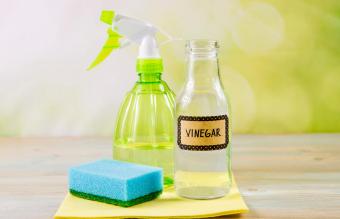
Lean in close — we're going to let you in on a little secret. You can use vinegar to clean hardwood floors. Yup, you read that right! Cleaning hardwood floors with vinegar is not only safe, but it's a great homespun alternative to the expensive professional-grade cleaners at the store. When you're running low on time but high on mess, turn to the pantry and these easy steps.
Vinegar Makes Hardwood Floors Shine
If you've had hardwood floors for a while, then you know they require special care to keep their beautiful luster and finish. The last thing you want is to ruin them with a new cleaner.
Fortunately, vinegar is an organic substance, and it's 100% biodegradable. So, you can use vinegar to clean your floors without worrying about exposing your partner, pets, and kids to dangerous toxins. What's more, ordinary household vinegar is known to kill bacteria, mold, and viruses. So, when used properly, vinegar is a cleaning win.
Related: Easy DIY Methods to Remove Scuff Marks From Hardwood Floors
How to Clean Your Hardwood Floors With White Vinegar
Cleaning hardwood floors with vinegar takes very little work. The only extra steps outside of your usual floor cleaning routine are to dilute the vinegar in some warm water and dry the floors after mopping. Besides that, grab these materials and follow our instructions to make your hardwood floors shine.
Materials You'll Need
- Vacuum/dry mop
- White vinegar
- Warm water
- Bucket
- Mop
- Towel
Instructions
- Declutter the floor, including furniture. You want a blank canvas to work on.
- Block off the room so pets and kids can't walk across the floor mid-cleaning. While vinegar is nontoxic, footprints and paw prints on a clean floor don't add to the décor!
- Next, vacuum or dry mop the floor. It's critical that you remove all the surface dust, dirt, lint, and hair before mopping.
- Mix white vinegar and warm water in a clean bucket. Use ½ cup of white vinegar to one gallon of warm water.
- Dip a mop in the solution and wring it out until it's damp-dry. Never use a soaking wet mop on the floor.
- Mop the floor, starting in one corner, always pushing in the direction of the floorboards. This should cut down on visible streaking.
- Rinse the mop head frequently and change water if the solution looks very dirty.
- Dry your floors completely after mopping.
Leftover water can lead to your floods swelling, buckling, and discoloring. To avoid this, pass over your floors with a towel multiple times until the water is fully absorbed.
Distilled White Vinegar & Water Are Where It's At
There's a lot of debate over whether vinegar is safe to use on hardwood flooring. Detractors call attention to the fact that vinegar's acidity can eat away at the floor's finish. Over time, you might find your floors lacking that usual luster.
Distilled white vinegar mixed with the right amount of water is much less acidic, meaning there's not enough acidity to eat away at the floor's finishing.
So, when you use vinegar in a homemade wood floor cleaner solution, choose distilled white vinegar. Not only is it the least expensive, but it isn't pigmented so it won't stain your floors.
While water should cut down on some of the vinegar's smell, make sure you open up windows and doors (if the season allows) to keep the smell from lingering.
Vinegar Is Safe, Effective, and Easy
Whether you have ethical or environmental concerns about artificial cleaners or don't feel like paying a steep fee to get groceries delivered, vinegar is just a few steps away. Get that streak-free clean and shine with this homemade vinegar hardwood floor cleaner.







